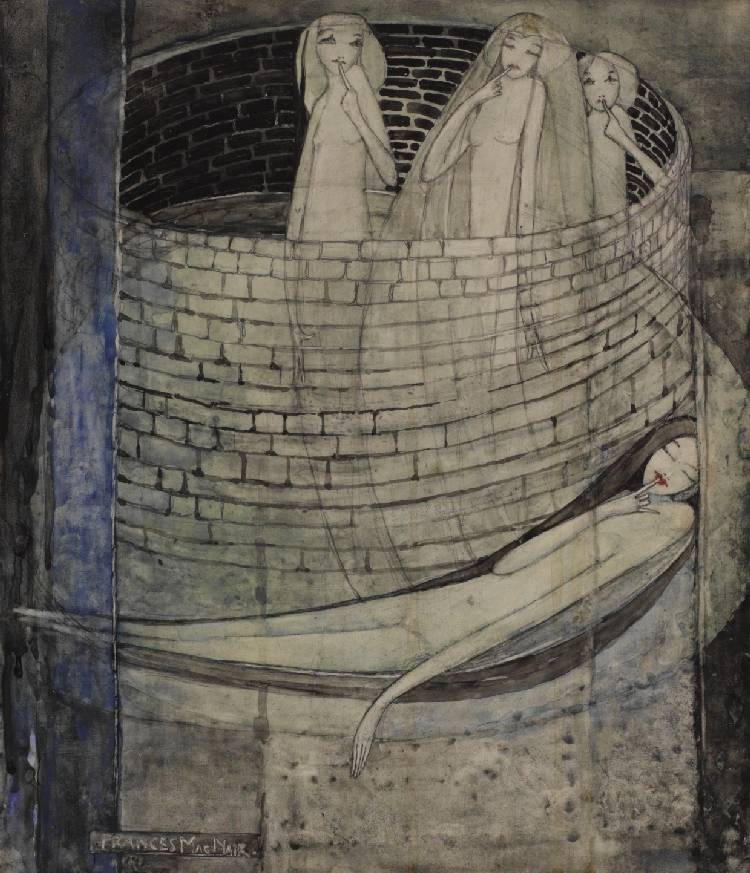Most people have heard of Art Nouveau, but few remember two of the most influential figures in its conception. (No, not Gustav Klimt.) They were a pair of sisters named Margaret and Frances MacDonald, who, along with their Glasgow School of Art classmates Charles Rennie Mackintosh and Herbert MacNair, comprised the Glasgow Four. Art Nouveau wouldn’t be what it is without them.
Straddling the turn of the twentieth century, from roughly 1890 to 1914, a new kind of art emerged in Europe and America. It used linear, plant-like forms, and drew from science, nature, mythical history, gender, and modernity for inspiration. People called it, simply, Art Nouveau. (Literally, new art.) The Glasgow Four were in art school as Art Nouveau was taking shape. They drew from Victorian Puritanism and Celtic Spiritualism and created ground-breaking pieces. Elongated bodies and a characteristic dreamy palette are ever-present. Colors are light, neutral, metallic, natural and mythical at the same time. And yet, there are touches of modernity, like geometric symmetry and the use of squares.
Together, the two women and two men of the Glasgow Four achieved an exceptionally rare “balance of gendered qualities” in their combined work. And for some critics, the sexual tension underneath the collaboration of the four is undeniable.
Perhaps this explains the nude women that feature in many of the pieces. It was uncommon for female painters to paint a nude woman in the 1890s. The nudes have a certain neutrality—they are portrayed as independent, ethereal and not submissive.
The way women are portrayed in Margaret and Frances’s work echoes their own independence. Whereas many women studied art more for personal pleasure than profession, the sisters readily sold theirs. And upon graduation, they set up their own studio. Janice Helland writes that their posters, advertisements, watercolors, metalwork, and fabric designs sold well, and they exhibited across Europe for several years. Contemporaries marveled at the sisters’ metalwork—a heavy, dirty process that women usually avoided—and at their unity. They co-signed much of their early work, and even forgot which of them had done what. But then they married Charles and Herbert and the dynamic changed.
Frances and Herbert moved south to Liverpool, to a university job and family life. They filled their home with their creations, while Margaret and Charles stayed in Glasgow. Charles was becoming a famous architect and furniture designer and Margaret now designed primarily for his projects. She was his muse and his colleague.
One of the most important moments for the four was the 1900 Vienna Secession. Klimt had been involved in establishing the Secession, and in 1900 they invited the Glasgow Four to exhibit. Almost everything Frances and Herbert showed was something from their house, whereas Margaret and Charles brought their commercial designs.
They were a huge success in Vienna, and sold all of their work. What’s more, they were engaged to produce work in Vienna. The most important assignment was the Wärndorfer music room, installed in 1902 and 1906 (gesso panels). The furniture and interior design influenced Hoffmann and Moser’s later work. As for Klimt, he was entranced. It is readily said that his Beethoven Frieze in panels was influenced by the Glasgow Four, in particular Frances’ piece entitled Sleep from 1899. Roger Billcliffe and Peter Vergo wrote that Mackintosh’s use of squares was “imitated by the Austrians to such an extent that it acquired the status almost of a leitmotif, especially in their typographic work and book decoration.”
Weekly Newsletter
But the heart of the Art Nouveau movement was Vienna. And when they returned to Glasgow and Liverpool, even though they were very busy, they were too remote to remain key to the movement. Within a few years, Margaret and Charles moved south to be nearer to London, but establishing a new clientele was difficult. Making matters worse, economics and war took their toll. Frances and Herbert lost their money in the 1909 financial crisis and Frances ended up supporting them with part-time jobs. Her disillusionment defines her later work. Helland points out that pieces like Man makes the beads of life, but woman must thread them (1912-15) vacillated between refusing to please and seeking to please. And in 1921 when Frances died of a cerebral hemorrhage at the age of 48, Herbert destroyed much of her work and refused to ever draw again. More appreciated in Germany and Austria than at home, Charles was falsely accused of spying for Germany during WWI. Within two years of Frances’ death, Charles and Margaret moved to France to live quietly and paint.
Of the Glasgow Four, Charles Rennie Mackintosh is now the most well-known. But traces of each of the Glasgow Four exist in his work. Every October Glasgow holds a Creative Mackintosh Festival. Visitors can move around the city during the festival, discovering traces of the Glasgow Four. The Kelvingrove and Hunterian museums have permanent displays of the four artists, but they are largely forgotten to the rest of the world. Is it time, perhaps, to rediscover these two sisters whose brilliance is a part of the “signifier of modernity” that was Art Nouveau?












